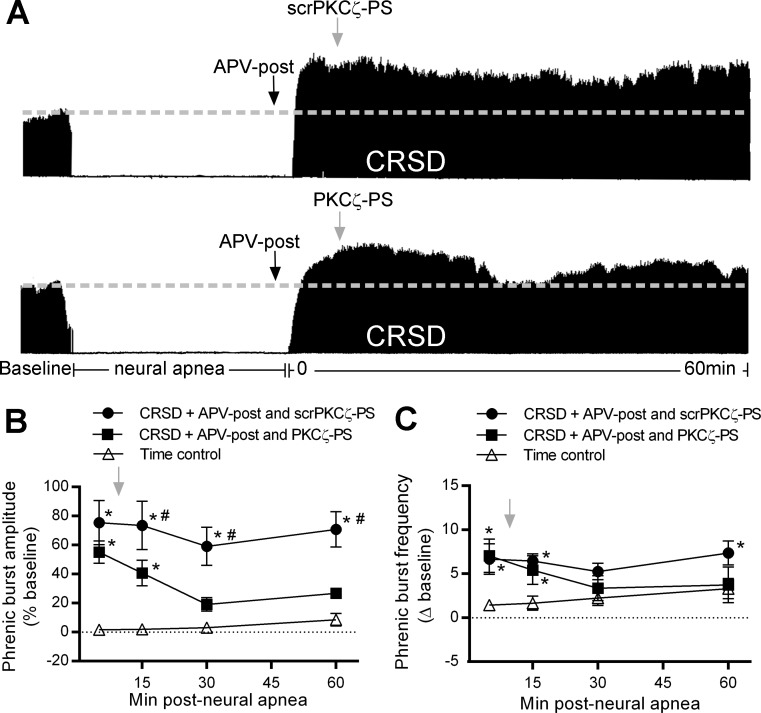Fig. 4.
Long-lasting iPMF in CRSD rats receiving APV requires spinal atypical protein kinase C (aPKC) activity. A: representative compressed phrenic neurograms depicting baseline, 30 min of neural apnea, and for 60 min after the resumption of phrenic neural activity in CRSD rats receiving intrathecal APV-post and either the scrambled version of the atypical PKC inhibitory peptide, myristoylated scrambled ζ-pseudosubstrate peptide (scrPKCζ-PS) or the atypical PKC inhibitory peptide, myristoylated ζ-pseudosubstrate inhibitory peptide (PKCζ-PS) 10 min after the resumption of neural activity. Black arrows denote intrathecal delivery of APV-post; gray arrows indicate intrathecal delivery of scrPKCζ-PS or PKCζ-PS. B: average phrenic burst amplitude (% baseline) for 60 min post neural apnea or an equivalent duration in time controls (triangles) in rats receiving APV-post and scrPKCζ-PS (circles) or PKCζ-PS (squares). Gray arrow indicates intrathecal delivery of scrPKCζ-PS or PKCζ-PS. CRSD rats receiving APV-post and scrPKCζ-PS express a significant increase in phrenic burst amplitude relative to time controls at all time points post neural apnea, indicating that the scrambled peptide did not impair long-lasting iPMF enabled by NMDAR inhibition. By contrast, CRSD rats receiving APV-post and PKCζ-PS expressed a small but significant increase in phrenic burst amplitude compared with time controls only at 5 and 15 min post neural apnea; however, phrenic burst amplitude was not significantly increased from time controls at 30 or 60 min. Furthermore, phrenic burst amplitude in CRSD rats receiving APV-post and PKCζ-PS was significantly lower than in CRSD rats receiving APV-post and scrPKCζ-PS, indicating that long-lasting iPMF in CRSD rats enabled by NMDAR inhibition requires spinal aPKC activity. C: average phrenic burst frequency (Δ baseline) for 60 min post neural apnea or an equivalent duration in time controls (triangles) in rats receiving APV-post and scrPKCζ-PS (circles) or PKCζ-PS (squares). Gray arrow indicates intrathecal delivery of scrPKCζ-PS or PKCζ-PS. CRSD rats receiving intrathecal APV-post and scrPKCζ-PS expressed a significant increase in phrenic burst frequency from time controls at 5, 15, and 60 min post neural apnea. CRSD rats receiving APV-post and PKCζ-PS expressed a significant increase in phrenic burst frequency from time controls at 5 and 15 min post neural apnea. Values are means ± SE. *Significantly different than time controls; P < 0.05.

